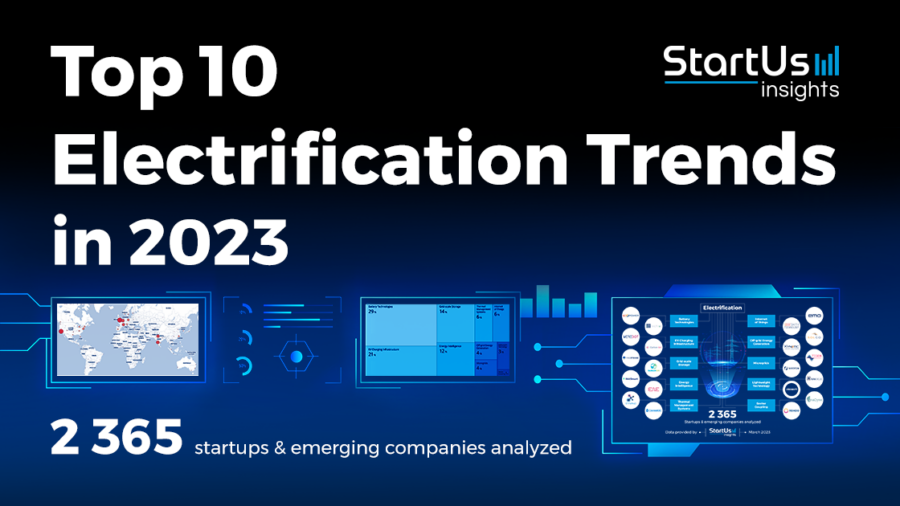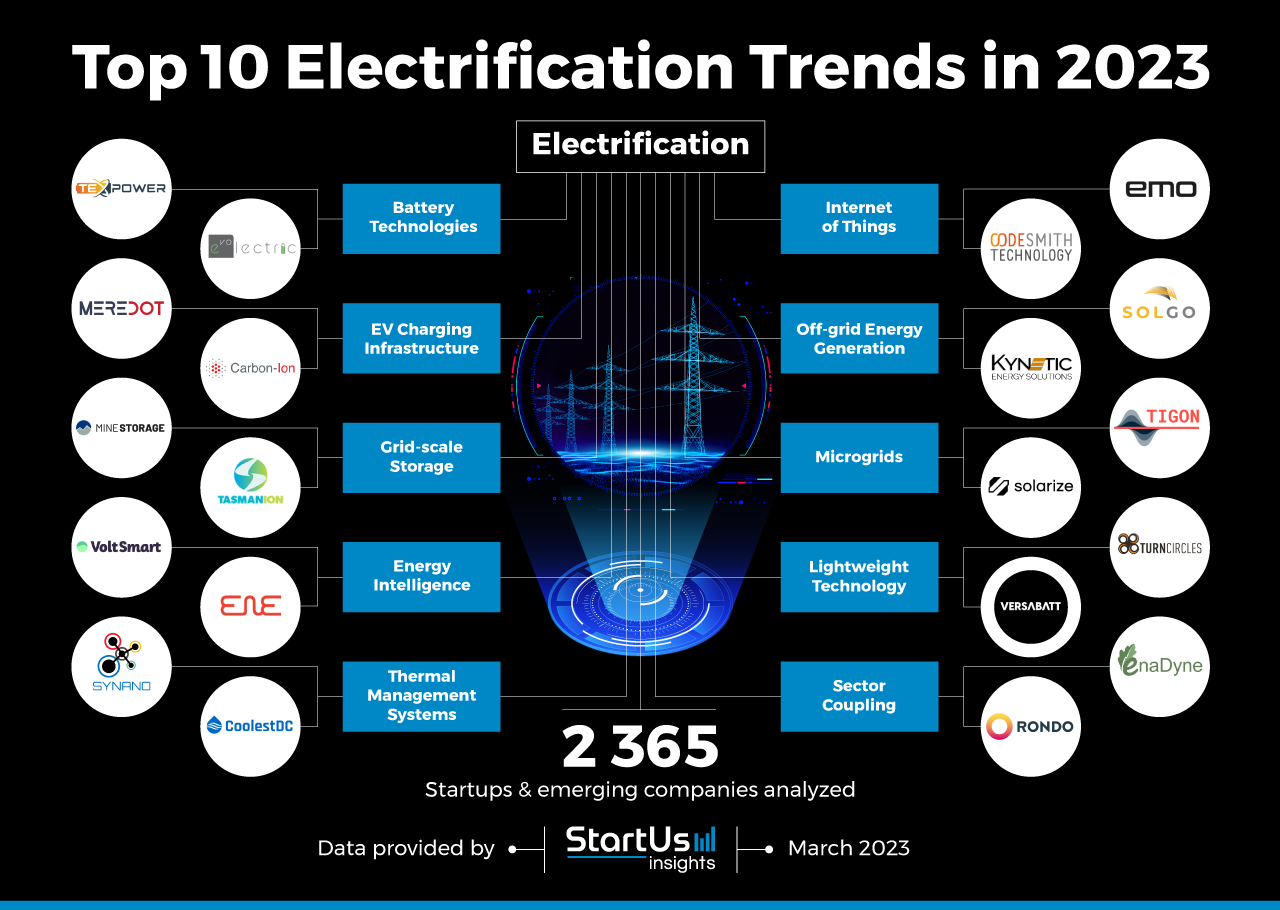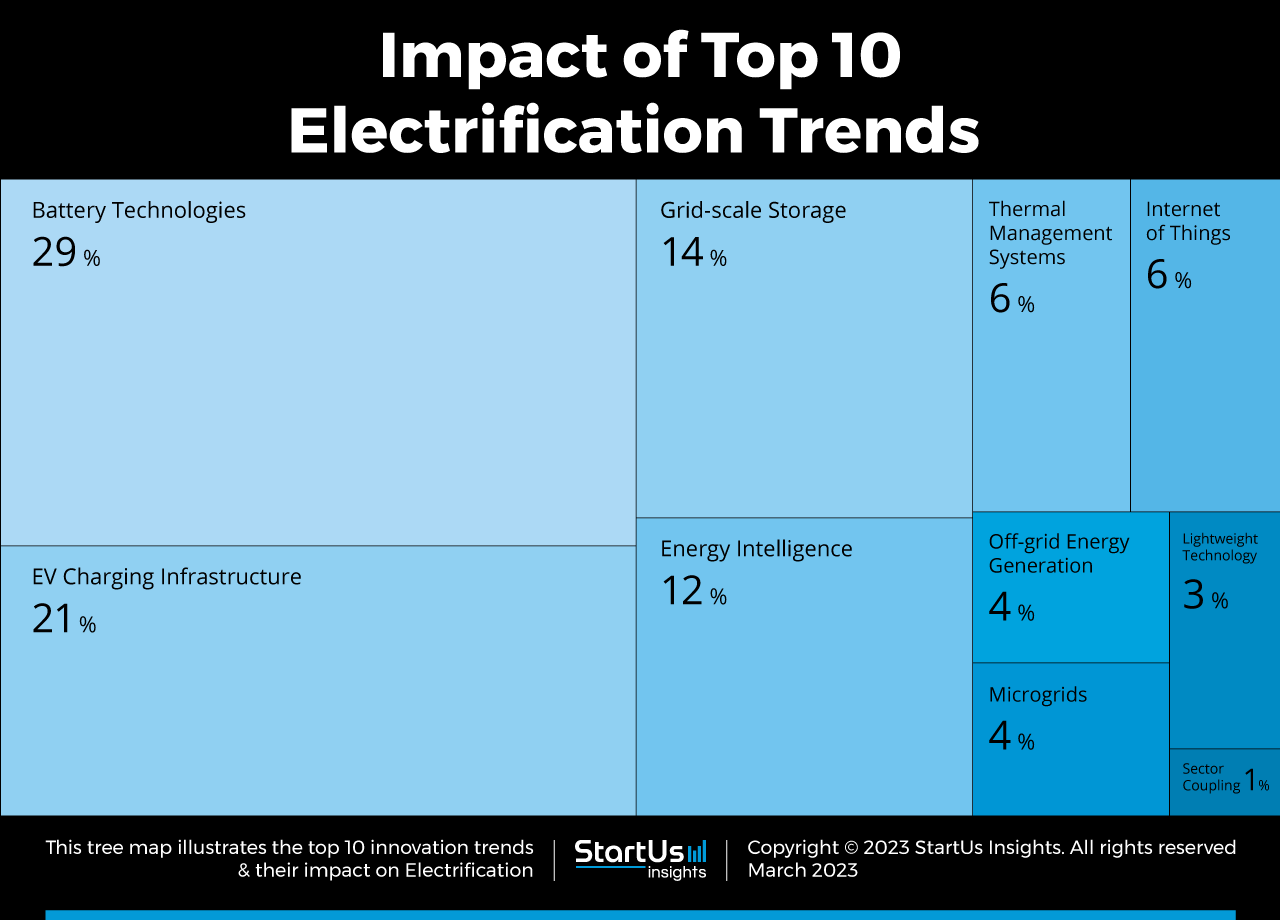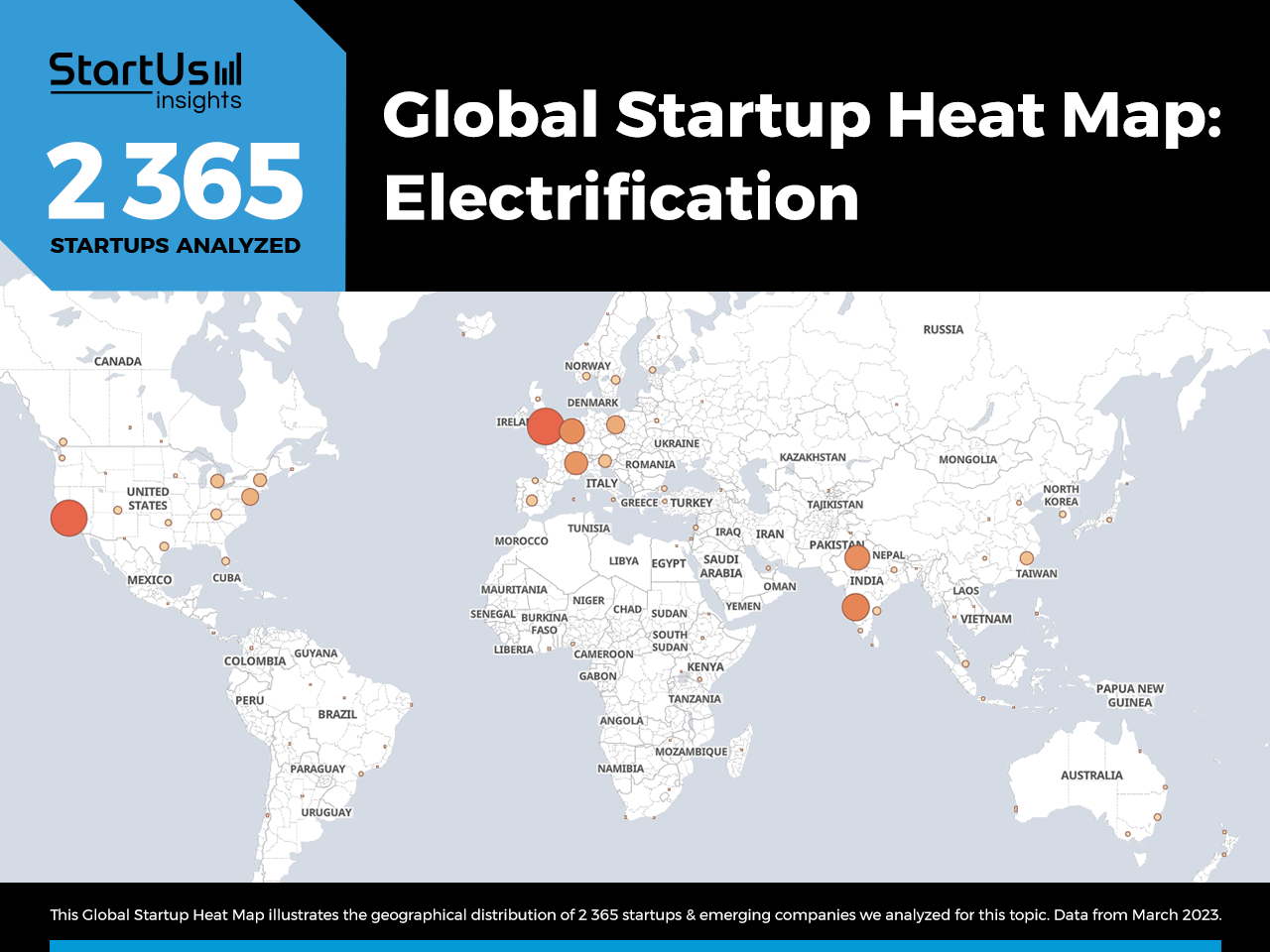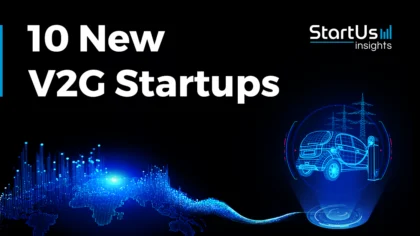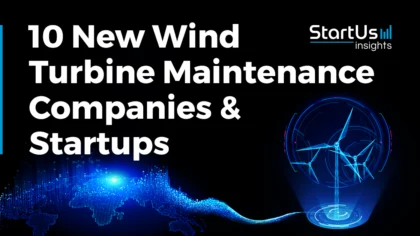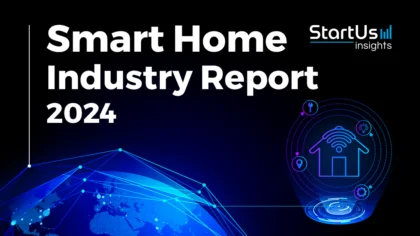Electrification aids companies across industries to adapt to the changing energy needs and combat climate change. To achieve this transition, industries leverage innovative technologies. However, the efficient functioning of such systems requires the electrification of every energy-consuming system, from steel furnaces to home power generators. To accommodate this, startups and scaleups develop technologies and products that replace fossil-powered counterparts that do not require specialized energy inputs. This data-driven research provides you with the top 10 global electrification trends in 2023 based on our research on 2 365 startups and scaelups. They range from energy storage systems and energy intelligence to the internet of things (IoT) and sector coupling. Read more to explore all trends and discover how startups enable electric alternatives in an oil-powered world.
Innovation Map outlines the Top 10 Electrification Trends & 20 Promising Startups
For this in-depth research on the Top Electrification Trends & Startups, we analyzed a sample of 2 365 global startups & scaleups. The result of this research is data-driven innovation intelligence that improves strategic decision-making by giving you an overview of emerging technologies & startups in the electrification industry. These insights are derived by working with our Big Data & Artificial Intelligence-powered StartUs Insights Discovery Platform, covering 2 500 000+ startups & scaleups globally. As the world’s largest resource for data on emerging companies, the SaaS platform enables you to identify relevant startups, emerging technologies & future industry trends quickly & exhaustively.
In the Innovation Map below, you get an overview of the Top 10 Electrification Trends & Innovations that impact 2 365 companies worldwide. Moreover, the Electrification Innovation Map reveals 20 hand-picked startups, all working on emerging technologies that advance their field.
Top 10 Electrification Trends in 2023
- Battery Technologies
- EV Charging Infrastructure
- Grid-scale Storage
- Energy Intelligence
- Thermal Management Systems
- Internet of Things
- Off-grid Energy Generation
- Microgrids
- Lightweight Technology
- Sector Coupling
Tree Map reveals the Impact of the Top 10 Electrification Trends
Based on the Electrification Innovation Map, the TreeMap below illustrates the impact of the Top 10 Electrification Trends in 2023. Startups and scaleups are developing battery and charging technologies to facilitate the hassle-free operation of electric mobility solutions. Advances in energy intelligence powered by advanced data analytics offer insights into asset utilization and optimization. Additionally, off-grid generation and microgrid solutions enable the pooling of available local renewable sources to address the huge energy demand posed by electrification. Innovations in thermal management systems and related electronics further improve the efficiency of electric systems. Lastly, sector coupling ensures the decarbonization of operations by interconnecting energy-consuming sectors.
Global Startup Heat Map covers 2 365 Electrification Startups & Scaleups
The Global Startup Heat Map below highlights the global distribution of the 2 300+ exemplary startups & scaleups that we analyzed for this research. Created through the StartUs Insights Discovery Platform, the Heat Map reveals that Europe and the US see the most startup activity.
Below, you get to meet 20 out of these 2 365 promising startups & scaleups as well as the solutions they develop. These 20 electrification startups are hand-picked based on criteria such as founding year, location, funding raised, & more. Depending on your specific needs, your top picks might look entirely different.
Top 10 Electrification Trends in 2023
1. Battery Technologies
Battery technologies optimize the energy-power tradeoff and maximize energy density through advanced materials and designs. With the increasing demand for customized battery packs, startups further apply engineering analytics to cut development costs. Further, sustainability requirements allow innovators to leverage battery chemistries that eliminate heavy metals like cobalt and cadmium. Otherwise, startups recycle or dispose of batteries to ensure a minimal impact on the environment. All of these make innovations in battery technology a critical trend for widespread electrification.
TexPower develops Cobalt-free Batteries
US-based startup TexPower combines its patented cobalt-free Nickel Manganese Aluminum (NMA) cathodes, high-energy anodes, and electrolytes to produce ultra-high energy cell systems. They are reliable, safe, and cost-efficient, supporting applications for electric vehicles (EVs) and electrified aircraft propulsion systems. The startup’s proprietary battery elements deliver higher energy density than commercial nickel cobalt aluminum (NCA) / nickel manganese cobalt (NMC) batteries in any form factor and system.
Evolectric offers Modular Battery Systems
US-based startup Evolectric specializes in electrified transportation and battery technologies. The startup’s customized battery hardware and software solutions enable the realization of both one-off products and scalable solutions for e-powertrains. The customization process involves rapid prototyping, engineering analysis, modeling, and simulation that facilitates application-based battery sizing. Additionally, Evolectric’s battery management system allows for the seamless integration of battery packs with the e-powertrains. This way, the startup reduces development costs and provides optimized powertrains for EV manufacturers.
2. EV Charging Infrastructure
Improvements in charging time, affordability, and convenience greatly affect the adoption of electric vehicles. Charging infrastructures that offer high-wattage and ultra-fast chargers extend a vehicle’s range in only a few minutes. Additionally, technologies, like DC fast charging, reduce the crowding of charging points installed along heavy traffic corridors. Further, inductive charging equipment enables wireless charging, improving the flexibility of EV charging. Wireless energy transfer also aids the integration of vehicle-to-grid (V2G) technology at charging stations. Sensors and smart devices track charging activities to further ensure safety and optimize operational costs.
Meredot makes a Wireless Charging System
Latvian startup Meredot provides a wireless charging system that allows for charging at contact and over the air. Predominantly catering to electric scooters, the startup’s charging pads do not require precise positioning and allow power transfer over a distance of 15 cm. The technology allows power transfer through asphalt, cement, snow, rain, or ice, enabling installations on the surface or underground. Meredot’s solution thus provides a single platform for the charging of shared and private mobility companies.
Carbon-Ion enables Fast Charging
US-based startup Carbon-Ion develops an ultrafast, high-power charging system that offers improvements over commercially available supercapacitors. The system stores energy with a combination of lithium-based batteries and supercapacitors to deliver high performance. It offers high, specific power that extends the lifetime of lithium-based batteries while enabling fast charging. The startup’s technology upgrades the power output of recharging stations where the grid infrastructure is limited.
3. Grid-scale Storage
Grid-scale storage plays an important role in electrification as it improves the operating capabilities of the grid and lowers costs. It also ensures high reliability and reduces infrastructure investments. Innovations in grid storage technologies, such as pumped hydro, compressed air energy, thermal energy, and flywheel storage, offer more flexibility with variable power sources and higher energy demands. These advances accelerate the integration of renewable energy sources like wind and solar into the grid, maximizing the output of renewable assets. This electrification trend ultimately alleviates the need for mining traditional power generation sources like coal and natural gas.
Mine Storage provides Low-Carbon Energy Storage
Swedish startup Mine Storage develops a flexible grid-scale energy storage solution for bulk storage and ancillary services. The startup sets up pumped hydropower storage solutions in abandoned mines. Utilizing the existing infrastructure lowers construction costs and the environmental impact of new greenfield storage infrastructure. Mine Storage’s operational model optimizes revenues based on the conditions of the local energy market. This allows grid operators to adjust for production gaps and fluctuations in supply and consumption.
TasmanIon offers Grid-scale Battery Storage
TasmanIon is a New Zealand-based startup that makes aluminum-ion batteries suited for grid storage and portable applications. The startup’s technology leverages aluminum cells with non-flammable electrolytes and safety-regulated design. The combination of materials also enables higher energy density compared to other batteries used in stationary storage such as lead-acid and redox flow. The startup’s battery solution serves as a cost-effective and scalable solution to balance surges during periods of high energy demand.
4. Energy Intelligence
Modern mechatronic vehicles feature electronic sensors, controls, and actuators along with software for data processing and computations. These capabilities allow vehicle manufacturers to leverage to optimize vehicle performance, EV charging, and maintenance infrastructure. Data analysis techniques like machine learning and predictive modeling manage large volumes of data and enable high-throughput data generation, gathering, and processing. Startups offering predictive analytics solutions for EVs and their supporting systems analyze driver and passenger behavior to alter vehicle settings. Big data analytics also drives better decision-making in planning for new EV infrastructure development and integrations.
VoltSmart enables Automated Charging
Estonian startup VoltSmart offers data-driven software for remote energy consumption management for EVs. The startup’s machine learning (ML) algorithms predict the required energy and departure time of EV drivers. It then automatically charges the EVs during periods of lower energy rates and cleaner power production. VoltSmart’s automated charging solution lowers operational costs and makes electrification accessible and sustainable.
EVE Mobility facilitates Fleet Electrification
Irish startup EVE Mobility develops an e-mobility intelligence platform. It utilizes ML to facilitate corporate fleet electrification. The platform combines vehicle and grid data to analyze costs associated with running EV fleets. EVE Mobility’s other software tools monitor the current fleet operation state to create a comprehensive sustainability report. This way, the startup allows fleet owners to electrify their assets faster and at lower costs.
5. Thermal Management Systems
Efficient thermal management is crucial for electric devices to ensure their optimal performance and efficiency. This electrification trend includes all innovative heat management solutions that maintain batteries, power electronics, and electric motors at optimal temperatures. Such cooling systems dissipate excess heat from electrical components and devices using air-cooled, liquid-cooled, or thermoelectric cooling systems. Startups utilize innovative designs and technologies like phase change materials, microchannel cooling, microfluidic cooling, and nanofluidic cooling systems. Apart from the performance improvements, advanced thermal management systems further ensure safe and reliable operations of electric systems.
Synano develops Nanofluid Coolants
Dutch startup Synano offers nanofluid coolants for electronics. The startup’s cooling system ensures proper and uniform heat dissipation. For electromagnetic machines, like linear motors, this enables more efficient cooling. The startup’s solution increases productivity, reduces downtime, and improves the resilience of electric machines.
CoolestDC provides Liquid Cooling systems
Singaporean startup CoolestDC designs and develops cooling solutions for power electronics, EV batteries, and high-powered electronic devices. The startup’s proprietary oblique-fin liquid and two-phase cold cooling solutions are customizable to fit unique requirements. CoolestDC’s cold-plate designs cater to tight space constraints that are essential for EV applications to create energy-efficient systems.

6. Internet of Things
IoT is a key enabler of asset digitization, data collection, and computational capabilities in electrification efforts to better manage interconnected assets. It enables the real-time transfer of information and allows EV manufacturers to stay competitive and keep up with global challenges. Therefore, startups offer IoT solutions that deliver insights into charging times, weather conditions, cable position, etc. IoT also enables features like remote monitoring that aid in early fault detection and diagnosis, reducing infrastructure and machinery maintenance costs.
EMO Energy simplifies Battery Failure Prediction
Indian startup EMO Energy develops ZEN PAC, a battery pack equipped with a platform that enables adaptable operations. The platform’s AI model, Sense AI, utilizes multiple sensors to capture cell parameters. It predicts patterns and prevents potential incidents by controlling power with the startup’s other product, ZEN Ctrl. The sensors also detect cell punctures and trigger the thermal management system that rapidly extracts the heat from the affected cell, ensuring battery pack safety.
CodeSmith offers Real-time Battery Monitoring
UK-based startup CodeSmith provides IoT solutions to enable real-time battery monitoring. The startup’s IoT platform, Battery Passport, captures information on battery usage securely and in real-time, reporting problems affecting performance and battery life. Its intelligent reporting feature offers detailed information and alerts that facilitate battery health monitoring and fault response in real-time. The solution also stores verified battery maintenance data that provides transparency to second-hand users when the batteries are no longer useful.
7. Off-grid Energy Generation
In remote locations, off-grid energy solutions offer a more cost-effective alternative to extending existing grids. These solutions allow end users to easily move away from grids that utilize fossil-powered generation and adopt non-polluting energy sources. Current developments include photovoltaic (PV) panels, modular wind turbines, and small hydropower or wave systems, separately or as hybrid generation systems. Further innovations include charge controllers, power conditioning equipment, safety equipment, meters, and instrumentation. This aids in realizing reliable power, cost reduction, and sustainable electrification.
Sol-Go provides Off-grid Solar Solutions
US-based startup Sol-Go manufactures lightweight, flexible plastic solar panels for off-grid power generation. The startup’s solar panels combine high-efficiency monocrystalline silicon solar cells with its proprietary flexible no-line grid design. They are corrosion-resistant and waterproof, making them suitable for off-grid applications and recreational vehicles both on land and sea.
Kynetic provides Hybrid Off-grid Power
Canadian startup Kynetic makes a hybrid off-grid energy solution that combines vertical wind turbines, solar products, lithium battery energy storage, and controllers to ensure optimized energy production. The startup’s clean, renewable power offsets operational costs involved with military mobility operations, telecommunications towers, mining camps, and electrifying remote indigenous communities. This way, Kynetic reduces diesel fuel demand and greenhouse gas (GHG) emissions in off-grid, generator-dependent requirements.
8. Microgrids
Microgrid technology supports the development of a flexible and efficient electric grid by integrating distributed energy resources (DERs), such as solar and geothermal energy. Microgrids strengthen grid resilience and mitigate grid disturbances as well as ensure faster system response and recovery. Additionally, the use of local energy sources shaves off peak loads and reduces energy losses in transmission and distribution. As a result, this increases the efficiency of electric delivery systems. Further, innovative software-driven solutions improve the agility of microgrids and allow for easy upgrades and increased control.
Tigon develops Decentralized Renewable Microgrids
Spanish startup Tigon offers modular DC microgrids that integrate solar power, energy storage systems, EV charging points, and other DC load systems. The startup’s software and hardware solutions include solid-state transformers, DC/DC converters, energy management systems, and a decision support system that speeds up hybrid microgrid rollout. These solutions enhance the reliability and resilience of decentralized renewable-based power systems by simplifying energy transition for grid operators.
Solarize offers a Microgrid Operating System (OS)
German startup Solarize creates a microgrid operating system that manages on-site energy production, distribution, and billing in commercial microgrids. It features an intuitive user interface, smart automation, and monitoring tools in a single app to track microgrid operations. The OS aids utility companies, microgrid operators, and owners of electricity production units to sell electricity on-site. This accelerates electrification through the better integration of on-site renewable assets.
9. Lightweight Technology
Using lightweight solutions in electric vehicles offsets the weight of power systems, improves efficiency, and increases range. Advances in lightweighting include developing new composite materials and innovative structural designs. They improve the performance-to-weight ratio, on-road handling, and EV stability. Apart from EVs, startups also focus on reducing the weight of batteries and inverter systems. This improves the portability of electric components and accelerates the replacement of fossil-powered power backups like diesel generators. Moreover, lightweight technologies translate to compact and power-saving solutions that reduce the total cost of EV ownership, while improving their performance.
Turncircles makes an Axial Flux Lightweight Motor
Czech startup Turncircles manufactures an ultra-light custom electric motor for aerospace and mobility applications. It offers higher power-to-weight performance compared to conventional radial flux motors. The parametric motor model design is scalable and stackable, enabling short development lead times. Its design also makes assembly and repair easy. This way, the lightweight motor lowers power consumption and maintenance requirements of electric solutions for aerospace and mobility companies.
MOOV Drive Technology provides Lightweight Battery Storage
Norwegian startup MOOV Drive Technology offers a compact, environmentally-friendly, and lightweight energy storage solution. It provides safe, quick, and easy access to energy at home and on the go. This replaces conventional lead acid batteries that are bulky and avoids the need for fossil fuel-powered backup generators. This facilitates the electrification of auxiliary power units utilized for domestic purposes.
10. Sector Coupling
Energy storage technologies, power-to-X (P2X) applications, and demand-response solutions interlink the power-producing sector with power-demanding sectors. They include buildings (heating and cooling), transport, and industrial operations. Startups and scaleups develop innovative power generation and chemical processes that produce stable output under varying energy inputs. These sector coupling solutions improve the flexibility of electric power systems while aiding variable renewable energy source integration. This tackles the challenges in power-consuming sectors associated with securing reliable electrification and achieving decarbonization goals.
enaDyne provides Plasma Catalysis-based Reactors
German startup enaDyne develops plasma catalysis-based reactors. The startup’s reactors selectively utilize renewable energy to convert CO2, green hydrogen, or green methane into green chemicals and e-fuels. enaDyne’s catalysis technology also mitigates the intermediate step to produce syngas, saving resources and time. The startup’s power-to-X solution enables mobility and transportation providers to leverage carbon-neutral e-fuels to accelerate the transition to e-mobility.
Rondo advances Power-to-Heat Conversion
US-based startup Rondo offers a power-to-heat solution to run industrial processes. The startup’s heat battery turns low-cost, intermittent electricity from sources like solar and wind energy into heat and stores it using refractory bricks. It delivers this stored heat as either superheated air or superheated steam, acting as a drop-in replacement for fossil-powered boilers. Rondo’s solution offers the chemical and heavy industries a low-cost pathway to electrification and reduces operating costs.
Discover all Electrification Trends, Technologies & Startups
The electrification trends advance the progress toward carbon neutrality with the integration of AI and IoT. They enable data-driven monitoring of electrified assets and facilitate faster decision-making. This simplifies the electrification plan and optimizes assets according to demand forecasts. Startups also work to improve the efficiency and reliability of electrical systems and devices to accelerate the transition from fossil-powered energy.
The Electrification Trends & Startups outlined in this report only scratch the surface of trends that we identified during our data-driven innovation & startup scouting process. Among others, transaction energy, V2X, and novel power electronics will transform the sector as we know it today. Identifying new opportunities & emerging technologies to implement into your business goes a long way in gaining a competitive advantage. Get in touch to easily & exhaustively scout startups, technologies & trends that matter to you!
